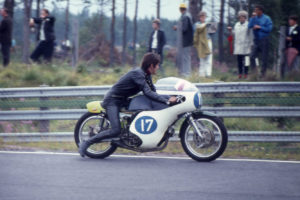
Part I – Some biographical elements
A. Before HEUER : Electronics, Mechanics and Motoracing
My name is Jean Campiche, and I was born on January 25, 1945. I live in Lausanne enjoying a magnificent view of the Léman lake. Today, I’m interviewed by Ikonic Stopwatch about life in formula 1, sports in general, and improvements in timing, focusing on precision, reliability, and innovation.
I studiyed at primary education, and secondary science school. Then I entered l'”Ecole de métiers”, where I got a diploma in radioelectronics. After that, I pursued engineering studies and graduated in 1964 with a engineering ETS (Higher Technical School,now HEIG) degree.
I loved mechanics, so much that teachers suggested I join the mechanical engineering section rather than continue with electronics. I said no; my real desire was to get a degree in electronics engineering.
But my real passion was the mechanics of internal combustion engines and above all riding two-wheelers. So I trained a lot with different tuned bikes. I wished to be an official driver for a racing team. So, with my financial limited resources, I took part in international races and, achieving good results, the world championship races. Every year, I scored points for finishing in the top ten. I was a private rider who had to buy second-hand bikes, or build models by hand, assembling competition engines and custom-made frames.
In addition of these expenses, added travel to various races, bike maintenance with parts and accessories regularly replaced, repairs following crashes and the engine breakdowns, which were much more frequent than today. It was a passion that already required a big budget. To maximize my chances of achieving my dream, I contacted many companies and organizations to offer me a presence and visibility in the world of motor racing, in exchange for a financial support… Unfortunately I was unsuccessful… A little later I also contacted manufacturers taking part in grand prix events to offer my services as a rider (MV Agusta, Benelli, Honda and Yamaha). They were all very polite in their replies, but there was no real hope of me getting a ride.
At the end of 1972, I realised that without sponsorship, it was nearly impossible to continue in motor racing. A motorbike costs 30 or 40,000 Swiss francs. What’s more, to continue in this discipline I would have had to compete in two categories, which meant spending 80,000 Swiss francs to buy two bikes. Then there was a bus to transport the bikes… The final budget was around 100,000 to 120,000 Swiss francs. Even if I worked a lot in an electronics company during the winter, I couldn’t spend that kind of money.
Editor’s note: Even before he met Jack Heuer, HEUER ceo, Mr Campiche shared many passions and similarities with him. They both came from engineering schools teaching new technologies at that time, enjoyed speed, skiing, motor sports and innovation.
B. Hired by HEUER: timekeeping for Ferrari, public and commercial relations
So I started reading job ads, wondering where I could work… And, in the early 1972 winter, in the Lausanne newspaper, I came across an article with the logo of HEUER, a Bienne base timekeeping specialist company I didn’t know at the time . They were looking to hire someone to manage timekeeping for an unamed prestigious Italian racing team, which turned out to be Ferrari. As well as the timekeeping technical aspect, the job required commercial skills and ‘PR’ (a term I didn’t know, which stood for ‘Public Relations’). I made an offer. A lot of people (around 50) replied. After an initial screening, there were only 10 people left. In the end we were only two. It was a bit special because the other person was a Longines timing department executive. Finally I was chosen, thanks to my passion and knowledge for motor sports and my contacts with a number of organisers, sponsors and managers… And I was an engineer in electronics, a technology that was going to be used more and more in the field of timekeeping. So on 1 January 1973, I was officially hired by HEUER, a company specialising in the manufacture of chronographs, industrial counters, sports counters and dashboards… There was already an electronic timekeeping department, headed by François Prinz.
My number one priority was to carry out the timing for Ferrari and manage the installations on their private track at Fiorano. 45 HEUER photocells connected to a Centigraph were placed around this small 1 kilometre circuit. The recorded split times were processed by a huge Olivetti computer, which calculated acceleration, corner entry and exit speeds, lap times, and so on. It was the first private circuit in Europe, if not the world, to be equipped with such a professional timing system.
My other priorities were to develop close links with the teams, journalists and organisers. Between competitions, I had a commercial mission to promote and sell timing equipment to circuits, organisers and sports federations. Ferrari was the first to benefit from our products, which were then bought by other teams. I sold Le Mans installations to Williams, Brabham, Tyrrell, Shadow Surtees and Mclaren.
- CREDITS
- banner picture : xtrztk.com
- visual 1 : Jean Campiche riding his motorbike in 1970 – by Torbjörn and Christer Johansson – pejer.info
Feel free to share suggestions or improvements for this article using this form.
